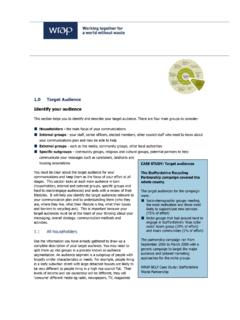Transcription of 2 Designing Training Program - UNITAR
1 1 Designing A Training PROGRAMByDr K I SudderuddinSingapore International FoundationAfghan Fellowship 2006 Workshop I^^^Kabul, Afghanistan24-28 May 200601 of 13 Designing a Training ProgramA Training design is a detailed plan for what you will do, why you will be doing it, and the best ways to reach your objective. The Eight Steps to an effective Training Program are:Step 1: Define purpose of Training and target audienceStep 2: Determine Participants needsStep 3: Define Training goals and objectivesStep 4: Outline Training contentStep 5: Develop instructional activitiesStep 6: Prepare the written Training designStep 7: Prepare participant evaluation formStep 8: Determine follow-up activities for the event02 of 132 Designing a Training ProgramStep 1: Define purpose of Training andtarget audience Be clear about what your Training needs hopesto accomplish.
2 Prioritize Be clear who your target audience will down clear purpose of Training and target audience03 of 13 Designing a Training ProgramStep 2: Determine Participants needsThe more accurately you know the needs of your participants the better your Training design will be. Find out their needs and expectation by: Get participants to complete a brief, written survey Survey a random sample of participants by phone tocollect more detailed information. Ask them:-current roles and responsibilities- previous Training on this topic- reasons for attendance- specific needs and expectation of event Review past evaluation and feedback forms5 Collect information early and use it to design your training04 of 133 Designing a Training ProgramStep 3: Define Training objectivesClearly defined objective provide criteria for.
3 YClarifying expect outcomesyOutlining Training contentyPlanning specific Training activitiesySelecting/developing materialyDesigning evaluation proceduresyCommunicating Program intent to participants & othersyEnsuring Training is realistic and appropriate5 Develop overall and segment (lesson) objectives and present them to participants at start of each of 13 Designing a Training ProgramStep 4: Outline Training contentWrap-up and evaluation component: Here pull it all together . Highlight essential learnings; summarize central concepts and themes; describe next steps. Open up for questions, concerns, gave 3 components: an introduction; a learning component and a wrap-up and evaluation component: Concepts and ideas taught and explored; skills demonstrated, practiced and discussed.
4 Activities should actively involve participants in acquiring knowledge or practicing : Establish a positive learning environment; stimulate interest; reduce anxiety and build bonds. Include some content into introductory to repeat stated objectives and outcomes toguide Program content and remind you of your of 134 Designing a Training ProgramStep 5: Develop instructional activities Organize activities so that outcomes identified are achieved. Activities should have an introduction, a main segment and a wrap-up segment. Select Training strategies that meet objectives, , skill development is best achieved through modeling, practice and feedback while information is achieved through discussion and collaborative group work.
5 Effective Training design takes into account principles of adult learning; group size; participant learning style; prior experience/education level of participants, type of skill or information to be presented, and so that promote active learning includebrainstorming, games, mini-lectures, small work groups,simulations, role-playing, case studies, you need to develop resource materials, , handouts, case studies,, questionnaires, of 13 Designing a Training ProgramStep 6: Prepare the written Training design Write a detailed plan of the Training session, including goals and objectives; the sequence of specific learning activities and time allotted to each; directions and key points to cover for each activity, and the trainer who will be responsible for the activity.
6 Consider the skill, expertise, Training style, and comfort level of each trainer and who will lead in fleshing out different the detailed plan to stay on track, make mid-course adjustments and document Training details08 of 135 Designing a Training ProgramStep 7: Prepare participant evaluation formEvaluation determines if the Training has achieved itsobjectives and to identify what needs to be evaluation form should ask the following:yDid participants acquire the skills and knowledge they were supposed to?yWere the trainers competent?yWere the activities interesting and effective?yWas the Training format appropriate?yWas the Training on this topic adequate?
7 Of 13 Designing a Training ProgramStep 8: Determine follow-up activities for the eventFollow-up activities provide continued support and feedback. Prepare follow-up activities as you develop your Training design and these activities should make participants reflect on what they have learned and the process of implementation. Some activities include:yNewsletters and website postingsyPeer observation and coachingyMentoringyStudy groups yOngoing communication between participants and trainees5 Follow-up activities require more resources but increase the likelihood of significant learning of 136 Designing a Training ProgramGuidelines for Training of TrainersPlanning/preparation checklist for facilitatorsyList qualities of your best trainer/facilitator.
8 Identify your weak points and try and improveyWork as a team and assign roles: presenter, facilitator, note-taker, logistics person, for a suitable venue and ensure you haveall visual materials, , paper, pens, flipchart, etc,needed and check your audio-visual aidsyEnsure fieldwork dates convenient for peopleyPrepare well and rehearse11 of 13 Designing a Training ProgramGuidelines for Training of TrainersGood techniques/practices for trainingyRelax and energize participants and facilitate name-learning; use an ice-breaker yEnsure everyone knows aims and objectives of workshopyGet a sense of participants level of knowledge andexpectationsyAgree to rules of workshop: mutual respect; one speaker at a time; no mobile phones; punctuality, a variety of communication methods and visual aidsyStart everyday with a recap of the previous dayyAlways build in an evaluation of the Training for future improvements12 of 137 Designing a Training ProgramGuidelines for Training of TrainersAttitude/behavior as facilitatoryBe open and honest; stay relaxed and calmyBe a good listener; observe, record, not judge , this is bad, this is good.
9 Or humiliate peopleyBe aware of language barriers; sensitivitiesyDo not let arguments dominate discussion; re-focus on key topicyHave eye contact, speak slowly and clearly; move aroundyTry and involve all participantsyUse humour, stories, examples, words that capture interestyAddress questions, concerns while sticking to your message 13 of 13








